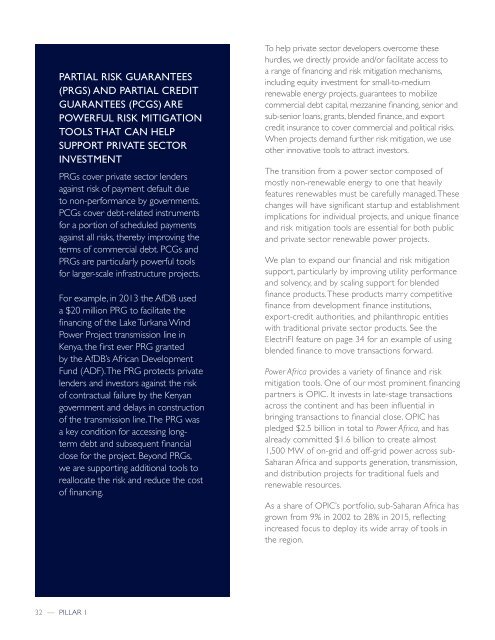THE ROADMAP
1Qw0wPK
1Qw0wPK
You also want an ePaper? Increase the reach of your titles
YUMPU automatically turns print PDFs into web optimized ePapers that Google loves.
PARTIAL RISK GUARANTEES<br />
(PRGS) AND PARTIAL CREDIT<br />
GUARANTEES (PCGS) ARE<br />
POWERFUL RISK MITIGATION<br />
TOOLS THAT CAN HELP<br />
SUPPORT PRIVATE SECTOR<br />
INVESTMENT<br />
PRGs cover private sector lenders<br />
against risk of payment default due<br />
to non-performance by governments.<br />
PCGs cover debt-related instruments<br />
for a portion of scheduled payments<br />
against all risks, thereby improving the<br />
terms of commercial debt. PCGs and<br />
PRGs are particularly powerful tools<br />
for larger-scale infrastructure projects.<br />
For example, in 2013 the AfDB used<br />
a $20 million PRG to facilitate the<br />
financing of the Lake Turkana Wind<br />
Power Project transmission line in<br />
Kenya, the first ever PRG granted<br />
by the AfDB’s African Development<br />
Fund (ADF). The PRG protects private<br />
lenders and investors against the risk<br />
of contractual failure by the Kenyan<br />
government and delays in construction<br />
of the transmission line. The PRG was<br />
a key condition for accessing longterm<br />
debt and subsequent financial<br />
close for the project. Beyond PRGs,<br />
we are supporting additional tools to<br />
reallocate the risk and reduce the cost<br />
of financing.<br />
To help private sector developers overcome these<br />
hurdles, we directly provide and/or facilitate access to<br />
a range of financing and risk mitigation mechanisms,<br />
including equity investment for small-to-medium<br />
renewable energy projects, guarantees to mobilize<br />
commercial debt capital, mezzanine financing, senior and<br />
sub-senior loans, grants, blended finance, and export<br />
credit insurance to cover commercial and political risks.<br />
When projects demand further risk mitigation, we use<br />
other innovative tools to attract investors.<br />
The transition from a power sector composed of<br />
mostly non-renewable energy to one that heavily<br />
features renewables must be carefully managed. These<br />
changes will have significant startup and establishment<br />
implications for individual projects, and unique finance<br />
and risk mitigation tools are essential for both public<br />
and private sector renewable power projects.<br />
We plan to expand our financial and risk mitigation<br />
support, particularly by improving utility performance<br />
and solvency, and by scaling support for blended<br />
finance products. These products marry competitive<br />
finance from development finance institutions,<br />
export-credit authorities, and philanthropic entities<br />
with traditional private sector products. See the<br />
ElectriFI feature on page 34 for an example of using<br />
blended finance to move transactions forward.<br />
Power Africa provides a variety of finance and risk<br />
mitigation tools. One of our most prominent financing<br />
partners is OPIC. It invests in late-stage transactions<br />
across the continent and has been influential in<br />
bringing transactions to financial close. OPIC has<br />
pledged $2.5 billion in total to Power Africa, and has<br />
already committed $1.6 billion to create almost<br />
1,500 MW of on-grid and off-grid power across sub-<br />
Saharan Africa and supports generation, transmission,<br />
and distribution projects for traditional fuels and<br />
renewable resources.<br />
As a share of OPIC’s portfolio, sub-Saharan Africa has<br />
grown from 9% in 2002 to 28% in 2015, reflecting<br />
increased focus to deploy its wide array of tools in<br />
the region.<br />
32 — PILLAR 1


